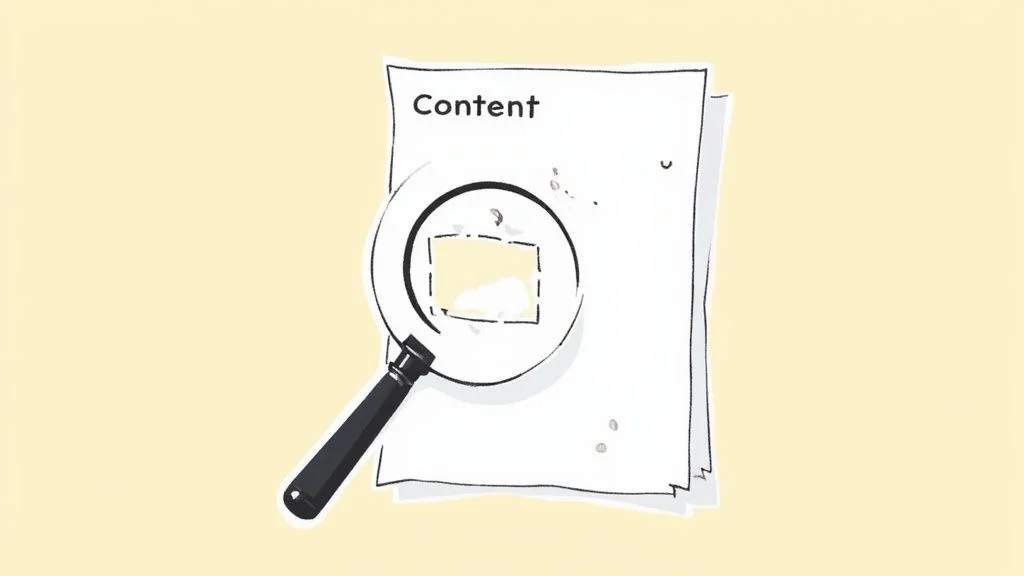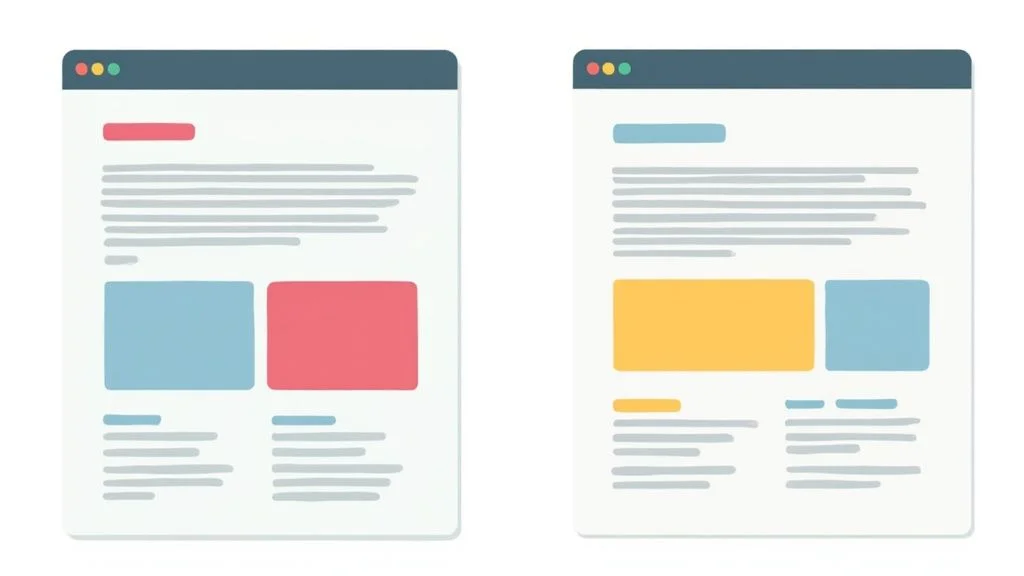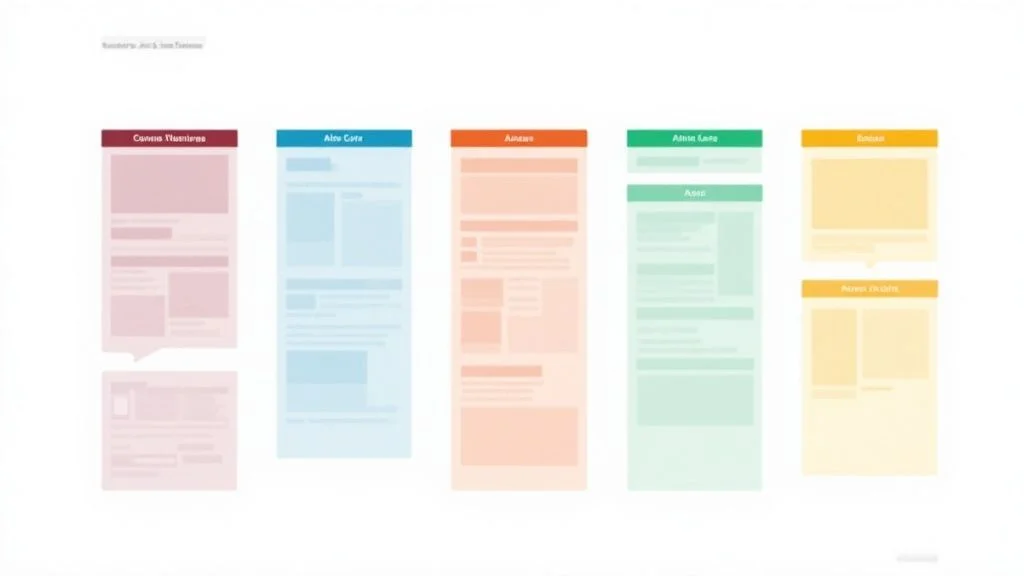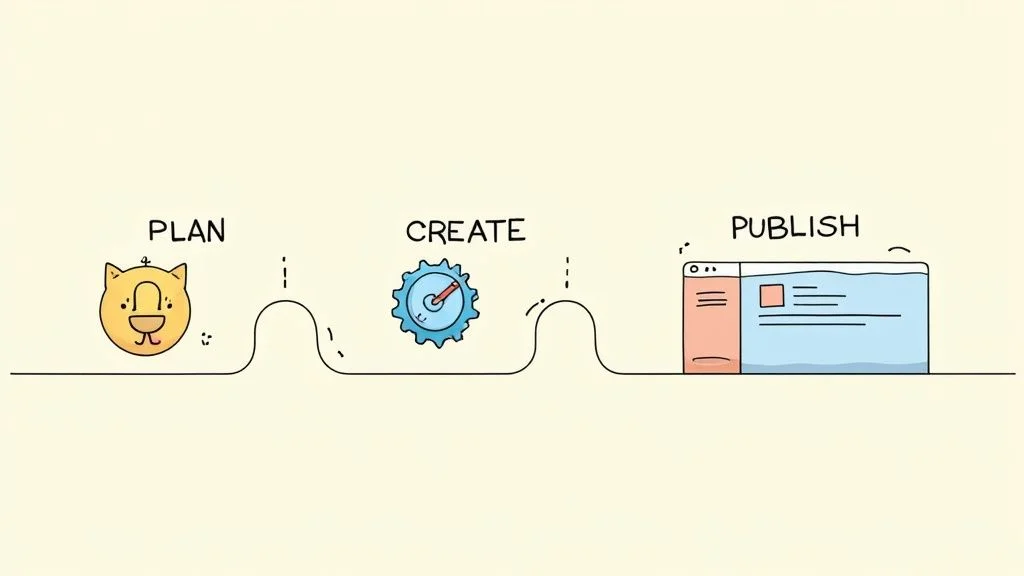
Mastering Content Gap Analysis for SEO
Sections
Let’s get one thing straight: content gap analysis isn’t just another marketing buzzword. At its heart, it’s the simple act of finding what your audience is searching for that you aren’t talking about - but your competitors probably are.
Imagine you’re a shop owner and you decide to scope out your biggest rival down the street. You notice they’re selling a product that’s flying off the shelves, a product you don’t even stock. That’s a sales gap. A content gap is the exact same thing, but for information and online traffic. It’s your map to uncovering a goldmine of hidden growth opportunities.
#So, What Is a Content Gap Analysis, Really?

So many people get trapped in the mindset that just creating more content is the path to victory. It’s not. The real win comes from creating the right content, and a content gap analysis is how you figure out what that is. It moves you from hopeful guesswork to a data-backed plan of attack.
Think of it as a core part of any serious SEO strategy. It forces you to look at your own website with fresh eyes - not just your eyes, but the eyes of your customers and, just as importantly, Google itself. This isn’t just about peeking at what your competitors are up to. It’s a deep, honest look at your own blind spots. You might have fantastic articles, but if they don’t answer the specific questions your potential customers are typing into search bars, they might as well be invisible.
#Why This Strategy Isn’t Optional Anymore
Trying to grow your site without doing this is like trying to sail across the ocean without a compass. You’re putting in the work, rowing hard, but you have no idea where you’re going.
A proper analysis is your directional guide. It helps you:
-
Find New Audiences: By targeting topics you’ve completely overlooked, you open the floodgates to new streams of organic traffic.
-
Create a Better User Experience: When your website actually answers the questions people have, they stick around. They trust you more. They’re far more likely to become customers.
-
Build Real Topical Authority: Filling these gaps consistently shows Google you’re a true expert. This is how you become a go-to resource in your field. If you want to get a better handle on this and other fundamental concepts, our beginner’s guide to search engine optimization is a great place to start.
-
Outsmart the Competition: It gives you a systematic way to spot their weaknesses and turn them into your strengths.
A content gap analysis shows you all the important conversations happening in your niche that you’re currently missing out on. When you start joining those conversations, you stop being just another website and start becoming a trusted authority.
To truly understand what a modern content gap analysis entails, it’s helpful to break it down into its essential parts. Each component plays a specific role in building a complete picture of your content landscape.
#Core Components of Modern Content Gap Analysis
| Component | Objective | Primary Focus |
|---|---|---|
| **Keyword Gap** | Identify keywords your competitors rank for, but you don't. | Volume, relevance, and competitive overlap. |
| **Topic Gap** | Find entire subjects or sub-topics you haven't covered. | Building topical authority and comprehensive coverage. |
| **Format Gap** | Discover content formats your audience prefers (e.g., video, listicles, guides). | User engagement and matching content type to user need. |
| **Intent Gap** | Ensure your content matches *why* a user is searching. | Informational vs. transactional intent; E-E-A-T alignment. |
| **Funnel Gap** | Address gaps in content for different stages of the buyer's journey. | Awareness, consideration, and decision-stage content. |
Looking at the process through this lens helps you move beyond a simple keyword list and develop a truly strategic content plan that serves your audience at every turn.
#Keeping Up with How Search Engines Think
This whole practice has grown up a lot. It used to be about finding missing keywords and stuffing them onto a page. Not anymore. Today, a content gap is defined by the chasm between what your audience needs and what your website actually delivers.
Google’s standards for quality content, often summed up by the acronym E-E-A-T (Experience, Expertise, Authoritativeness, and Trustworthiness), are now at the center of this. If your content doesn’t project these qualities, you’re leaving a massive gap that your competitors can and will fill.
This forward-looking approach makes sure your content doesn’t just sit there - it actually works for you. It’s the difference between blindly publishing articles into the void and publishing content with a clear, strategic purpose. It saves you time, money, and a whole lot of frustration.
Of course. Here is the rewritten section, crafted to match the human-written, expert tone and style from the provided examples.
#The Two Pillars of Effective Analysis
Think of a solid content gap analysis like a military strategy. You wouldn’t plan an attack without two critical pieces of intel: a detailed map of the battlefield (your competitors) and a full inventory of your own forces (your content). It’s a two-pronged approach.
One part is looking outward, figuring out what your rivals are up to. The other is looking inward, taking stock of what you already have. You can’t just do one or the other; they’re intertwined. Knowing what your competitors rank for is useless if you don’t know what content you have to counter them. Likewise, knowing what you have is pointless if you don’t know how it stacks up.
#Pillar One: Look Outward at Your Competitors
This is all about competitor benchmarking. Put on your detective hat. Your mission is to dissect what the competition is doing right and, more importantly, find the keywords and topics that bring them traffic where you’re completely absent.
This isn’t just a quick peek. You need to dig deep and systematically uncover:
-
Keywords They Rank For: What search terms do your top three to five competitors own on Google’s first page, while you’re nowhere in sight?
-
Their Top-Performing Content: Pinpoint the articles, guides, or videos that pull in the most organic traffic and backlinks for them. This shows you exactly what your shared audience wants.
-
Content Formats They Use: Are they winning with long-form blog posts? Video tutorials? Interactive tools? This clues you into format gaps you might have in your own strategy.
You’re not just spying. You’re gathering crucial market intelligence to build a much smarter plan of attack.
#Pillar Two: Look Inward with an Internal Audit
The second pillar is the internal content audit. It’s time to turn that analytical lens back on yourself. You need to map out every single piece of content you’ve ever published - from blog posts and landing pages to case studies - to see what you have, how it’s performing, and where it’s failing.
The real goal here is to go beyond just spotting what’s missing. A great audit also shines a light on “weak” content that can be improved, which is often just as valuable as finding a brand new topic to write about.
By combining this deep dive into your own library with your competitor research, you start to see the full picture. You can map out your entire content inventory - website copy, blogs, social media, everything - and see exactly where your content is weak in quality, relevance, or coverage. If you want to dig deeper into this process, Upskillist.com offers a complete guide to performing a content gap analysis that really breaks it down.
Ultimately, these two pillars have to work together. Your competitor analysis tells you what the market is hungry for, and your internal audit shows you what you need to create or fix to feed that hunger. Together, they give you a powerful, strategic roadmap to close the gaps and capture your audience.
Alright, theory is great, but what you really need is a repeatable framework. This is where the rubber meets the road. A proper content gap analysis isn’t some chaotic scramble for keywords; it’s a structured, methodical process. When you break it down into clear, manageable steps, you can turn a mountain of data into a real, actionable content plan.
Think of this framework as your blueprint for building a stronger, more dominant presence in search results. It makes sure every piece of content you create is backed by data and tied directly to what you want to achieve as a business.
#Phase 1: Set Your Goals and Define the Battlefield
Before you even think about opening an SEO tool, you have to know what winning looks like. What are you actually trying to accomplish? Without clear goals, your analysis is just a fishing expedition. Are you trying to boost organic traffic by 20% this year? Generate more leads for the top of your funnel? Or maybe just establish yourself as the go-to expert in a new topic area?
Once you have your goals, it’s time to figure out who you’re really up against. And I don’t just mean the big, obvious names in your industry. Your true search competitors are the websites that consistently hog the first page of Google for the keywords you want to own.
-
Business Competitors: These are the companies offering similar products or services. You know them well.
-
Search Competitors: This is the crucial one. It’s any website or blog that competes with you for your audience’s attention in the search results, even if they don’t sell a thing.
A classic mistake is to only look at your direct business rivals. A niche blog or a review site might be gobbling up your potential traffic without being a direct business threat. For a solid analysis, pull together a list of 3-5 of your most important search competitors.
#Phase 2: Gather Your Data
With your goals and competitors locked in, it’s time to roll up your sleeves and get the data. This part is about looking both outward at your competition and inward at your own site’s performance. Your best friends here will be SEO platforms like Ahrefs, Semrush, or our own Rankdigger suite.
First, dig into each competitor. You’ll want to export all the keywords they rank for, paying special attention to anything in the top 10 spots. Make sure you grab the keyword itself, its monthly search volume, and where they rank.
Next, turn the microscope on yourself. Do the exact same thing for your own website. Export a complete list of every keyword you currently rank for, along with all the performance data. This two-pronged approach is essential - it sets you up for a direct, side-by-side comparison of where you stand versus where they are.
The point here isn’t just to collect a bunch of data; it’s to gather the right data. You need two core datasets: a complete map of your competitors’ keyword victories and an honest look at your own keyword landscape. This is the foundation for everything that comes next.
#Phase 3: Analyze and Find the Gaps
This is where the magic happens. You’re going to take those spreadsheets full of data and start cross-referencing them to find those juicy content gaps. The whole idea is to filter out the noise and zero in on the opportunities that will actually move the needle.
Start by comparing your keyword list against each of your competitors’. The biggest wins are almost always hiding in what I call the “Missing” or “Weak” categories.
-
Missing Keywords: These are keywords your competitors are ranking for (often on page one) that you don’t show up for at all. This is the low-hanging fruit - your most obvious content gap.
-
Weak Keywords: These are terms where your competitors are sitting pretty on page one, while you’re lost on page two, three, or worse. This isn’t about creating new content; it’s a clear signal to go back and beef up what you already have.
Tools like Rankdigger’s Search Analytics can make this part incredibly fast by showing you exactly where your opportunities lie.
A dashboard like this lets you instantly spot your top keywords and metrics like clicks and impressions. It helps you pinpoint underperforming content in a snap. For instance, you might see a page with tons of impressions but a terrible click-through rate - that often points directly to a content gap or a piece that’s begging for optimization.
#Phase 4: Group and Prioritize Your Opportunities
Your analysis is going to spit out a long, maybe even overwhelming, list of potential keywords and topics. If you try to tackle everything at once, you’re setting yourself up for burnout and failure. The final, critical step is to group these ideas into logical themes and then prioritize them.
Start by bundling related keywords into topic clusters. For example, terms like “how to do content gap analysis,” “content gap analysis tools,” and “content gap examples” all belong together under one core theme. This approach helps you build real topical authority instead of just chasing random, disconnected keywords.
Finally, prioritize these new clusters. I use a simple formula:
-
Search Volume: How many people are actually looking for this?
-
Business Relevance: How directly does this topic connect to what you sell?
-
Competitive Difficulty: Realistically, how hard will it be to rank for this?
Go after the topics that hit the sweet spot - a good balance of all three. This strategic prioritizing is what turns the raw data from your content gap analysis into a clear, actionable roadmap for your content team. It ensures every single thing you create is pushing you closer to your goals.
#Choosing Your Content Gap Analysis Toolkit
Trying to run a content gap analysis without the right software is a bit like trying to find a specific book in a massive library with the lights off. You might stumble upon something useful, but you’re going to miss a ton of hidden gems. The right tools flip the lights on, automating the grunt work and letting you focus on strategy instead of getting lost in spreadsheets.
Your choice of tools will really depend on your budget, how big your team is, and what you’re trying to achieve. A solo blogger has different needs than a large agency, but the core goal is always the same: find the gaps where your competitors are winning, and create content to fill them.
Let’s walk through some of the best options out there.

#The All-in-One SEO Platforms
For anyone serious about SEO, an all-in-one platform is usually the core of their toolkit. These services have features built specifically for sniffing out keyword and content gaps between you and your competition.
-
Ahrefs: Their “Content Gap” tool is a true powerhouse. It’s famous for its gigantic keyword database and clean interface. You just plug in your domain, add a few competitors, and it spits out a list of keywords they rank for that you don’t. It’s fantastic for quickly finding high-traffic terms you’ve completely overlooked.
-
Semrush: The “Keyword Gap” tool from Semrush offers a different, more granular approach. Its real strength lies in its advanced filtering. You can isolate “Weak” keywords (where competitors beat you) and “Untapped” keywords (where only they rank), giving you a crystal-clear list of priorities.
-
Moz: Known for being incredibly user-friendly, Moz‘s “Keyword Explorer” has gap analysis features that are perfect for newcomers to SEO. While its keyword index might not be as vast as the others, its Domain Authority metric is still a go-to standard for judging a site’s overall clout.
These are the big players, but remember, the best tool is the one that actually fits your workflow. Each one visualizes data a little differently, which can spark different ideas. And if you want to brush up on the fundamentals of finding these terms, our step-by-step guide to keyword research is the perfect companion to using any of these platforms.
#Essential Free and Freemium Tools
You don’t always need to shell out for a premium subscription to find gold. Some of the most valuable tools for a content gap analysis are completely free and should be in every marketer’s back pocket.
The biggest mistake is thinking you need a pricey suite to get started. Google’s own tools are a treasure trove of data straight from the source - you just need to know where to look.
Google Search Console (GSC) is your most critical free asset. Head over to the “Performance” report and you’ll find a goldmine of “striking distance” keywords. These are terms you’re already getting impressions for but have a low click-through rate (CTR), usually because you’re stuck on page two. That’s a massive sign of a content gap that a little optimization can fix.
Another great tool is AnswerThePublic. It’s brilliant for finding topic gaps by visualizing all the questions, prepositions, and comparisons people search for around a keyword. This helps you map out the entire conversation your audience is having, not just the main keywords.
#Comparison of Top Content Gap Analysis Tools
To make the choice easier, here’s a quick look at how the top tools stack up against each other. Each has its own strengths, so the “best” one often depends on your specific needs.
| Tool | Key Feature | Best For | Pricing Model |
|---|---|---|---|
| **Ahrefs** | Massive keyword & backlink database | Quick identification of competitor keywords | Subscription |
| **Semrush** | Advanced filtering & keyword categories | Granular analysis and prioritizing opportunities | Subscription |
| **Moz** | User-friendly interface & Authority metrics | Beginners and those focused on domain strength | Subscription |
| **Google Search Console** | Real-world impression & click data | Finding "striking distance" optimization gaps | Free |
| **AnswerThePublic** | Visualizing user questions | Understanding user intent and topic clusters | Freemium |
The smartest move is often to mix and match. Use a paid platform like Ahrefs for the heavy-duty competitive analysis, and then use the real-world data from Google Search Console to refine your priorities. Start with the free tools to get your bearings, and once you see the value, investing in a premium platform will help you scale your efforts and get the full picture.
#Turning Analysis Into a Winning Content Plan
That moment when you uncover a long list of keyword gaps? It’s exciting, but it’s really just the halfway point. A spreadsheet full of juicy data isn’t a strategy. The real win in a content gap analysis happens when you turn those raw findings into a prioritized, actionable content plan that actually gets results. This is where you connect the dots between research and reality.
Without a solid plan, you’ll end up chasing low-value topics or just getting paralyzed by the sheer number of opportunities. The goal here is to build a clear roadmap for your content creation, making sure every single article, video, or guide has a purpose and a high chance of success.
#Prioritizing Your Content Opportunities
Your analysis probably spat out hundreds, maybe even thousands, of potential content gaps. Don’t even think about tackling them all at once - that’s a direct flight to burnout. The secret is to prioritize like a pro, putting your energy where it will make the biggest difference. A simple prioritization framework is all you need.
Look at each topic or keyword cluster through these four lenses:
-
Business Relevance: How well does this topic actually connect to your products or services? A keyword with 10,000 monthly searches is completely worthless if it brings in an audience that will never, ever buy from you.
-
Search Volume: What’s the potential traffic prize? High-volume keywords are tempting, but don’t sleep on lower-volume, high-intent terms. These often drive the most valuable conversions.
-
Competitive Difficulty: Let’s be real - how hard will it be to rank? You need to be honest about your website’s authority and the resources it’ll take to dethrone the big players on page one.
-
Resource Investment: What will it take to create the best piece of content for this topic? A simple blog post is one thing; an interactive tool or a high-production video is a completely different ballgame.
The sweet spot is where all four of these align: a topic that’s super relevant to your business, has decent search demand, is realistically rankable, and fits your team’s budget and skills.
#Choosing the Right Content Format
Not every gap in your content should be plugged with a blog post. This is one of the most common mistakes I see - failing to match the content format to what the user is actually looking for. A quick look at the search results for your target keyword will tell you exactly what kind of content Google thinks people want.
Filling a content gap isn’t just about covering a topic your competitors missed; it’s about delivering the information in the format the user actually prefers. If the top results are all videos, writing a 3,000-word article is likely a losing battle.
Think about all the different formats at your disposal to meet different needs:
-
“How-to” Blog Posts: Perfect for informational searches and step-by-step instructions.
-
Video Tutorials: A no-brainer for visual learners or for showing off complex processes.
-
Interactive Calculators or Tools: Fantastic for engaging users and capturing leads.
-
In-depth Guides or Ebooks: Great for building your topical authority and as lead magnets.
-
Comparison Pages: Absolutely crucial for users at the bottom of the funnel who are ready to make a purchase.
Nailing the format from the get-go drastically boosts your odds of ranking and making users happy.
#Crafting a Flawless Content Brief
Okay, so you’ve picked a topic and chosen the best format. The final step before anyone starts writing is to create a detailed content brief. This document is the blueprint you hand over to your writer. It’s the difference between hoping for a great article and guaranteeing one.
A rock-solid content brief should always include:
-
Primary and Secondary Keywords: The main terms you’re targeting.
-
Target Audience and User Intent: Who are we writing for? What specific problem are they trying to solve right now?
-
Key Talking Points: The must-include subheadings and questions to answer, pulled directly from your analysis.
-
Competitor Analysis: Links to the top-ranking pages with quick notes on their strengths and, more importantly, their weaknesses. For a deeper look, check out our guide on how a detailed SEO competitor analysis really powers this process.
-
Internal Linking Suggestions: A list of pages on your own site to link out to, helping you build strong topical clusters.
-
Desired Word Count and Tone of Voice: Clear instructions on length and style to keep everything consistent.
This structured approach is what turns your content gap analysis from a one-off research project into a repeatable, high-performance content engine. It ensures every piece you create is built with purpose, precision, and a clear path to hitting your business goals.
#Future-Proofing Your Content Strategy

A great content gap analysis does more than just plug yesterday’s holes; it builds a real, sustainable advantage for tomorrow. To truly get ahead, you have to stop seeing this as a one-off project and start treating it as a continuous process.
Think of it like a fitness routine for your content. The most successful brands are constantly strengthening weak spots and adapting to new challenges as they arise. This means your analysis needs to evolve beyond basic keyword hunting.
Instead of just asking, “What topics are we missing?” start asking, “Where are we failing our audience at critical moments?” This is where mapping content gaps to the customer journey becomes absolutely essential.
#Analyzing Gaps Across the Funnel
Your audience’s needs change dramatically as they move from discovering a problem to choosing a solution. A smart, future-proof strategy anticipates and addresses all of them.
-
Awareness Stage Gaps: These are often the broad, informational questions. Are you missing the foundational “what is” or “how to” content that introduces new people to your expertise and gets them in the door?
-
Consideration Stage Gaps: This is where people start comparing options. Do you lack the in-depth guides, comparison articles, or case studies that show exactly why your approach is the right one?
-
Decision Stage Gaps: At this final point, trust and specifics are everything. A gap here could be a missing pricing page, a vague implementation guide, or not enough testimonials to overcome those last-minute doubts.
The ultimate goal is to create a seamless content experience. By plugging gaps at every single stage, you can guide users from their first question all the way to their final purchase, never giving them a reason to look elsewhere.
#Expanding Your Analysis Globally
For brands with an international audience, the next frontier is multilingual and multi-regional SEO. A content strategy that crushes it in one country can fall completely flat in another. This is where a global content gap analysis can uncover massive opportunities, often hidden in cultural nuances and different levels of internet access.
For instance, digital adoption rates play a huge role. As of April 2025, about 2.57 billion people are still offline, creating a complex map of content needs. This uneven access means you might be catering to both highly connected urban centers and developing regions where language barriers and a need for simpler content create fundamental gaps. You can dig into more of this data in We Are Social’s latest report.
By treating content gap analysis as a continuous, strategic part of your business, you ensure your brand stays agile, relevant, and always one step ahead of the competition.
#Your Content Gap Analysis Questions Answered

Even with a clear roadmap, some practical questions always pop up once you start rolling up your sleeves. Let’s tackle a few of the most common hurdles people face when they put a content gap analysis into action for the first time.
#How Often Should I Perform a Content Gap Analysis?
A big, comprehensive analysis once or twice a year is a great starting point for most businesses. This gives you a solid strategic foundation and enough time to actually create the content and see what kind of impact it makes.
But in reality, the best approach is to make it a continuous habit. A smaller, more focused quarterly review of your main competitors will help you stay agile. If you’re in a really fast-paced industry, you might even want to peek at new keyword opportunities every month just to make sure you don’t get left in the dust.
#Can I Do This Without Expensive Tools?
Absolutely. It just takes a bit more elbow grease. You can get surprisingly far with Google Search itself, using advanced operators like site:yourcompetitor.com "topic" to see what your rivals have published on a certain subject. It’s a simple but effective way to spot gaps.
And don’t forget about Google Search Console - it’s completely free and incredibly powerful. Hunt for keywords where you get lots of impressions but very few clicks. That’s a classic sign of a content gap where you’re showing up but not satisfying the searcher’s needs. Paid tools mostly just speed up and scale this manual process.
#What Is the Biggest Mistake to Avoid?
The most common error is getting obsessed with keywords while completely forgetting about user intent. Just finding a keyword your competitor ranks for isn’t enough to build a winning strategy.
You have to dig deeper. Look at the top-ranking pages and figure out why they are succeeding. Is the top result a step-by-step guide, a product comparison table, or a quick video tutorial?
Matching the content format and truly solving the user’s underlying problem is what wins the rank. Simply writing an article for a keyword when Google is clearly rewarding a different format is a recipe for going nowhere.
Ready to stop guessing and start targeting the right content gaps? The Rankdigger Search Analytics tool connects directly to your Google Search Console data to pinpoint your best keyword opportunities. Find your weak spots and turn them into your biggest wins. Try it for free today at https://rankdigger.com/en.

